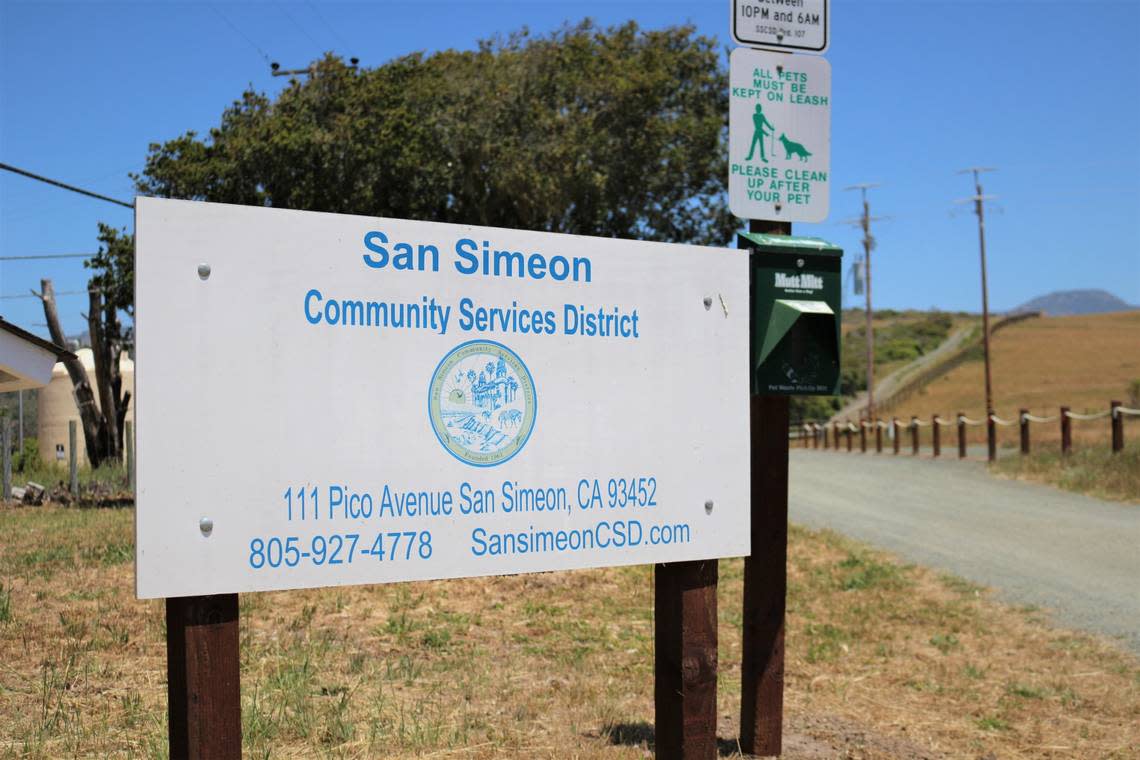A tiny SLO County CSD plans to disband. What does that mean for the district?

Faced with high-cost demands from governmental agencies, lawsuits and ongoing discord, San Simeon’s provider of water, sewage treatment and other services wants to close up shop after more than six decades.
San Simeon Community Services District’s four current directors voted unanimously Friday to officially start the process of shutting down the district and handing all its responsibilities to another agency, probably the county.
The tiny seaside community of about 460 residents is separated geographically from its most famous components, Hearst Castle and Old San Simeon Village, about 3.5 miles north on Highway 1.
Closing the district altogether was the most draconian of the two options facing the board members.
The other was to keep the small CSD intact to manage some lesser services (street lighting and maintaining non-county-owned streets, for instance) while shifting the water and sewage treatment to the “partner” agency.
The directors had decided in December that continuing as is, struggling and falling further behind, wasn’t on the table. They somberly reconfirmed that conclusion on Friday, directing staff to take the next steps toward closing the district.
Why might small coastal CSD disband?
The 61-year-old San Simeon district has wrestled with infrastructure and other issues as major as discovering it had built its recycled water plant partially on a neighbor’s property, and the California Coastal Commission requirement to move its wastewater treatment plant further away from the ocean.
Current cost estimates to go about fixing that are about $20 million, interim General Manager Patrick Faverty told the board during the meeting Friday.
Meanwhile, the district has also endured a series of management upheavals.
Following the 2004 departure of former district manager John Wallace, a few others sat in that seat for a while until the district hired APTwater, a firm that subsequently went bankrupt in 2014.
Charles Grace, an APT employee, stayed to fill the gap. Eventually, the CSD hired Grace’s firm, Grace Environmental Services, with Grace serving as acting general manager.
Since then, Grace has been involved in various legal battles over alleged conflict of interest.
Meanwhile the district lost grants and began facing the reality of all those looming expenses being required by the Coastal Commission and other agencies.
Relocating the wastewater treatment plant, fixing a broken pipe bridge and dealing with storm damage to a shore-access stairway were among the tasks confronting the district that had few, if any, options for paying for all that work.
Meanwhile, some who’ve waited decades to build on their property started suing — and winning — to get the water they need to proceed. And others have criticized the district’s board and management at every turn.
For decades, the CSD also has had difficulty filling out its five-member board, and some back-and-forth in the ultimate focus of those who were elected.
In an unusual move Friday, the current four district directors split the board chairmanship into quarterly assignments, with Jacqueline Diamond taking the gavel in April, Michael Donohue in July and Holly Le in November.
The length of latter’s stint at the helm will depend on the outcome of the Nov. 5 election, as her term was a fill-in appointment after the sudden April resignation of long-serving board member Gwen Kellas.
In her resignation, Kellas said she left the board because the environment was “toxic, harassing and demeaning.”
The board has notably been unable to find a replacement for Daniel De la Rosa, another longtime director who resigned that same month after accusing the district of lack of due process and “discriminatory and exclusionary practices” against Latino committee members.
What’s process for San Simeon CSD to disband?
Going from the board’s closure decision to actually disbanding the district is far from a simple process, and likely will take many months, if not a year or more, county officials have warned CSD directors.
Before it can happen, various studies, reports and the application for dissolution must be completed, an agreement hammered out with a partner agency, and all that submitted to the county’s Local Agency Formation Commission.
When and if the Commission approves the application, then it goes to the county, where Public Works will do another study, with a cost analysis report for county supervisors to consider.
Along the way, the public will have opportunities to comment — but few people were at Friday’s meeting, either in person or virtually.
If the application is approved, an official protest period also applies. Depending on how many protests are filed, they could trigger a vote of the people or even stop the dissolution altogether, LAFCO executive Director Rob Fitzroy told The Tribune in December.

